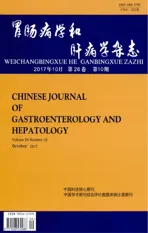儿童非酒精性脂肪性肝病的研究进展
2017-03-08呼敬雷王全楚
呼敬雷,程 龙,王全楚
解放军第153中心医院感染科,河南 郑州 450042
儿童非酒精性脂肪性肝病的研究进展
呼敬雷,程 龙,王全楚
解放军第153中心医院感染科,河南 郑州 450042
儿童处于快速生长发育阶段,其非酒精性脂肪性肝病(non-alcoholic fatty liver disease,NAFLD)的发病机制、发病率、临床与病理特征、诊治和转归均有别于成人,具有特殊性,儿童NAFLD特别是非酒精性脂肪性肝炎(non-alcoholic steatohepatitis,NASH)的诊治已引起临床医师的高度重视,现作一概述。
儿童;非酒精性脂肪性肝病;非酒精性脂肪性肝炎
自1983年首次报道了儿童非酒精性脂肪性肝病(non-alcoholic fatty liver disease,NAFLD)以来,全球对其研究越来越多。近年来,NAFLD低龄化趋势日益严重,已经影响到5%~10%的学龄儿童和44%~70%的肥胖儿童[1]。生活环境、家庭社会认知及基因多态性等因素在儿童NAFLD的发生、发展中发挥了重要的作用。
1 儿童NAFLD流行病学
超重和肥胖是导致近年来儿童NAFLD发病率上升的最重要原因。2014年Ng等[2]的全球性研究报告也显示,1980年-2013年,发达国家男童超重肥胖率从16.8%升至23.8%,女童从16.2%升至22.6%;我国台湾超声筛查显示,正常体质量儿童NAFLD的发病率为3%,超重儿童为25%,肥胖儿童为76%;肥胖儿童非酒精性脂肪性肝炎(non-alcoholic steatohepatitis,NASH)发生率为22%[3]。上海对1 180名9~14岁学生肝脏超声检查发现,NAFLD患病率为2.1%,其中肥胖儿童NAFLD患病率为68.2%[4]。
2 儿童NAFLD的发病机制
尽管儿童NAFLD的具体发病机制尚不明确,但环境、遗传和社会因素共同参与儿童NAFLD发生、发展的多因素协同发病机制愈来愈受到重视。
2.1环境因素
2.1.1 饮食因素:大量高热量非健康快餐食品已成为儿童NAFLD最重要的诱因[5]。一方面,多余的热量在体内转化成脂肪储存,引起肥胖及NAFLD,另一方面,高热量饮食还可能引发肠道菌群失调造成NAFLD的发生和发展[6]。有研究显示,长期胃肠外营养(total parenteral nutrition,TPN)的患者易发生脂肪肝。婴儿TPN 5 d即可出现肝酶和胆红素升高,2周就会出现脂肪肝,3个月发生肝汇管区纤维化。此外,食物中的果糖和胆固醇也会对儿童NAFLD产生不利影响[7-8]。其中,果糖引起的NAFLD患儿的血脂异常程度比健康儿童更明显[9];由于胆固醇代谢产物对脂肪酸合成的上调,导致儿童高TG及LDL血症,促进了肝细胞脂肪变性[10]。此外,出生后配方奶喂养的患儿更容易发生NASH,母乳喂养则具有保护作用[11]。另外,补充益生菌和长链ω3多不饱和脂肪酸可能对NAFLD患儿有正面效应。虽然运动可以刺激机体合成脂代谢酶且能从社会心理学角度加强对低热量饮食的执行力,但Meta分析[12]显示,有氧运动可以明显改善NAFLD患者的肝内脂肪,但对肝功能、血脂、BMI等方面并无明显改善作用。
2.1.2 肠道微环境:肠道微环境主要通过肠-肝轴和二次打击机制促使NAFLD的发生,并在肝脏炎症反应和纤维化中发挥重要作用。多项临床试验及动物实验均发现,给予NAFLD患者或实验动物益生菌治疗可以降低肠道渗透性,改善肠黏膜屏障功能,减少肠源性内毒素生成和吸收,改善肝脏的炎症坏死,减轻胰岛素抵抗(insulin resistance,IR)[6]。
2.2遗传因素
2.2.1 宫内环境因素:发育程序化理论认为在围产期营养和环境刺激可能导致后代的生理学和代谢变化,增加他们在生命中后期发生某些疾病的风险。有证据表明,母体肥胖将会导致后代体质量增加和脂肪堆积,发展为NAFLD。宫内环境之所以对婴儿代谢如此重要,是因为胎儿可能在宫内及婴儿早期形成自己的脂类代谢“调定点”,不良宫内环境可能会导致胎儿出生后诱发错误的适应性反应,引起患儿表观遗传学改变,通过激活相关基因,增加对脂类的摄取、合成和保存,引起儿童NASH等风险上升[13]。一项MRI的研究[14]结果表明,根据孕妇的BMI可以预测胎儿的肝内脂质蓄积,侧面验证了母亲肥胖和子女NAFLD的相关性。不难发现,当前怀孕的准妈妈们有60%是肥胖的。
2.2.2 基因组学研究:近年来研究发现,单核苷酸多态性(SNPs)降低了儿童对高热量饮食的耐受力,增加了儿童对NAFLD的遗传易感性。研究显示,一些基因SNPs可能与NAFLD发病有关:如影响lipin-1蛋白表达的rs13412852 SNPs与儿童血脂水平、NASH严重程度及肝纤维化显著相关[15];编码脂肪滋养蛋白磷酸酶结构域蛋白-3(NPLA3)基因突变,尤其是常见的rs738409 C>G多态性与肝脏脂肪变性及肝纤维化具有相关性[16];葡萄糖激酶调节蛋白rs2854116 SNPs可以使肥胖患儿更容易发生脂肪变性和血脂异常[17]。
2.3其他因素很多引起内分泌异常的原发病也是导致NASH及相关代谢紊乱的危险因素。另有研究[18]证明,NAFLD发病率与年龄及性别也有密切的关系,NAFLD高发年龄为8~14岁,男女比例约为2∶1。男童超重率、肥胖率均显著高于女童,除了养育观念和方式上的差异之外,性激素的差异也发挥了作用。
3 儿童NAFLD的病理学特点
儿童NASH比成人进展更快,预后也更差。美国NASH临床研究网络(CRN)报告入组儿童中30%发生了包括桥接纤维化和肝硬化在内的中度或重度纤维化[19]。英国51%的NAFLD患儿纤维化分期≥F2[20];意大利儿童NAFLD患者晚期肝纤维化分期(≥F3)比例为15%[21]。与成人相比,儿童NASH肝组织病理学表现更类似HBV感染,淋巴细胞浸润、纤维化多见于汇管区(腺泡1区)或无明显分区,罕见肝小叶内炎症浸润(成人多见),这可能也是儿童NASH疾病进展更快、疗效和预后更差的原因之一。
儿童在同一疾病中经常存在异质性。对于NAFLD来讲,相比于1型NASH,2型NASH的儿童年龄更小、肥胖程度更严重。一项英国系列研究中60%为2型NASH,20%同时合并有1型和2型NASH,没有发现典型的1型NASH儿童[22]。到目前为止,还不能将“快纤维化”与“慢纤维化”区分出来。随着全基因组关联分析(GWAS)的出现,针对哪些基因引起了更快速纤维化的基因分析研究将是下一步研究的热点问题。
4 儿童NAFLD治疗进展
儿童NAFLD尚无特效治疗药物,低热量均衡饮食和减轻体质量仍是儿童NAFLD一线非药物治疗的主要目标。药物治疗主要针对抗氧化、胰岛素增敏及细胞保护等三个靶点。但是目前针对儿童的药物研究大部分没有达到预定目标。尽管维生素E在成人NASH的治疗中显示出很好的疗效,但无论是二甲双胍还是维生素E对儿童NASH的炎症改善和纤维化改善均没有达到预设目标。这也提示儿童NASH发病机制可能与成人不同,需要进一步深入研究[23]。
5 预后与展望
在儿童NAFLD中,肥胖和IR的严重程度似乎是纤维化进展的信号。在为数不多的儿童NAFLD队列研究中,已有年仅10岁的孩子继发NASH肝硬化的报道[24]。尽管儿童NAFLD确切的发病机制尚不明确,但环境、遗传等多因素协同作用的“多重打击”致病机制逐渐被学界所认识。近年来基因和表观遗传学的研究为NAFLD诊断、分类及靶向治疗带来了新方向,NASH发病机制中的一些信号通路和分子将成为未来临床治疗的重要靶点。目前已进入Ⅱ、Ⅲ期临床试验的各种药物值得期待[25]。
[1] Clemente MG, Mandato C, Poeta M, et al. Pediatric non-alcoholic fatty liver disease: recent solutions, unresolved issues, and future research directions [J]. World J Gastroenterol, 2016, 22(36): 8078-8093.
[2] Ng M, Fleming T, Robinson M, et al. Global, regional, and national prevalence of overweight and obesity in children and adults during 1980-2013: a systematic analysis for the Global Burden of Disease Study 2013 [J]. Lancet, 2014, 384(9945): 766-781.
[3] Huang SC, Yang YJ. Serum retinol-binding protein 4 is independently associated with pediatric NAFLD and fasting triglyceride level [J]. J Pediatr Gastroenterol Nutr, 2013, 56(2): 145-150.
[4] Fan JG. Epidemiology of alcoholic and nonalcoholic fatty liver disease in China [J]. J Gastroenterol Hepatol, 2013, 28(Suppl 1): 11-17.
[5] Mosca A, Della Corte C, Sartorelli MR, et al. Beverage consumption and paediatric NAFLD [J]. Eat Weight Disord, 2016, 21(4): 581-588.
[6] Doulberis M, Kotronis G, Gialamprinou D, et al. Non-alcoholic fatty liver disease: an update with special focus on the role of gut microbiota [J]. Metabolism, 2017, 71: 182-197.
[7] Leung DH, Yimlamai D. The intestinal microbiome and paediatric liver disease [J]. Lancet Gastroenterol Hepatol, 2017, 2(6): 446-455.
[8] Sluik D, Engelen AI, Feskens EJ. Fructose consumption in the Netherlands: the Dutch national food consumption survey 2007-2010 [J]. Eur J Clin Nutr, 2015, 69(4): 475-481.
[9] Jin R, Le NA, Liu S, et al. Children with NAFLD are more sensitive to the adverse metabolic effects of fructose beverages than children without NAFLD [J]. J Clin Endocrinol Metab, 2012, 97(7): E1088-E1098.
[10] Papandreou D, Karabouta Z, Rousso I. Are dietary cholesterol intake and serum cholesterol levels related to nonalcoholic fatty liver disease in obese children? [J]. Cholesterol, 2012, 2012: 572820.
[11] Alisi A, Cianfarani S, Manco M, et al. Non-alcoholic fatty liver disease and metabolic syndrome in adolescents: pathogenetic role of genetic background and intrauterine environment [J]. Ann Med, 2012, 44(1): 29-40.
[12] 李兆伟, 林乔, 严祥, 等. 有氧运动对非酒精性脂肪性肝病疗效的Meta分析[J]. 胃肠病学和肝病学杂志, 2016, 25(4): 398-404.
Li ZW, Lin Q, Yan X, et al. Effect of aerobic exercise in non-alcoholic fatty liver disease patients: a Meta-analysis [J]. Chin J Gastroenterol Hepatol, 2016, 25(4): 398-404.
[13] Alisi A, Panera N, Agostoni C, et al. Intrauterine growth retardation and nonalcoholic fatty liver disease in children [J]. Int J Endocrinol, 2011, 2011: 269853.
[14] Brumbaugh DE, Tearse P, Cree-Green M, et al. Intrahepatic fat is increased in the neonatal offspring of obese women with gestational diabetes [J]. J Pediatr, 2013, 162(5): 930-936, e1.
[15] Valenti L, Motta BM, Alisi A, et al. LPIN1 rs13412852 polymorphism in pediatric nonalcoholic fatty liver disease [J]. J Pediatr Gastroenterol Nutr, 2012, 54(5): 588-593.
[16] Lin YC, Chang PF, Chang MH, et al. A common variant in the peroxisome proliferator-activated receptor-γ coactivator-1α gene isassociated with nonalcoholic fatty liver disease in obese children [J]. Am J Clin Nutr, 2013, 97(2): 326-331.
[17] Santoro N, Zhang CK, Zhao H, et al. Variant in the glucokinase regulatory protein (GCKR) gene is associated with fatty liver in obese children and adolescents [J]. Hepatology, 2012, 55(3): 781-789.
[18] Schwimmer JB. Clinical advances in pediatric nonalcoholic fatty liver disease [J]. Hepatology, 2016, 63(5): 1718-1725.
[19] Molleston JP, Schwimmer JB, Yates KP, et al. Histological abnormalities 3'in children with nonalcoholic fatty liver disease and normal or mildly elevated alanine aminotransferase levels [J]. J Pediatr, 2014, 164(4): 707-713, e3.
[20] Fitzpatrick E, Mitry RR, Quaglia A, et al. Serum levels of CK18 M30 and leptin are useful predictors of steatohepatitis and fibrosis in paediatric NAFLD [J]. J Pediatr Gastroenterol Nutr, 2010, 51(4): 500-506.
[21] Alkhouri N, Mansoor S, Giammaria P, et al. The development of the pediatric NAFLD fibrosis score (PNFS) to predict the presence of advanced fibrosis in children with nonalcoholic fatty liver disease [J]. PLoS One, 2014, 9(8): e104558.
[22] Cioffi CE, Welsh JA, Cleeton RL, et al. Natural history of NAFLD diagnosed in childhood: a single-center study [J]. Children (Basel), 2017, 4(5): E34.
[23] Nobili V, Manco M, Ciampalini P, et al. Metformin use in children with nonalcoholic fatty liver disease: an open-label, 24-month, observational pilot study [J]. Clin Ther, 2008, 30(6): 1168-1176.
[24] Molleston JP, White F, Teckman J, et al. Obese children with steatohepatitis can develop cirrhosis in childhood [J]. Am J Gastroenterol, 2002, 97(9): 2460-2462.
[25] Koot BGP, Nobili V. Screening for non-alcoholic fatty liver disease in children: do guidelines provide enough guidance? [J]. Obes Rev, 2017, 18(9): 1050-1060.
《胃肠病学和肝病学杂志》编辑部成员
段芳龄 李建生 王全楚 马 军 陈香宇
李 健 王豪勋 张艳丽 杨 林 范凯丽
冉孟娟
Progressofnon-alcoholicfattyliverdiseaseinchildren
HU Jinglei, CHENG Long, WANG Quanchu
Department of Infectious Diseases, the 153 Hospital of PLA, Zhengzhou 450042, China
Children are in the period of rapid growth stage, the pathogenesis, incidence, clinical and pathological features, diagnosis, treatment and prognosis of non-alcoholic fatty liver disease (NAFLD) in them are exceptive and different from adults. The diagnosis and treatment of NAFLD have attracted great attention of the clinicians, especially non-alcoholic steatohepatitis (NASH). This article summarized as follows.
Children; Non-alcoholic fatty liver disease; Non-alcoholic steatohepatitis
R575.5
A
1006-5709(2017)10-1094-03
2017-08-15
呼敬雷,主治医师,研究方向:各型肝病的临床诊疗。E-mail: 396171500@qq.com
王全楚,主任医师,硕士生导师,研究方向:慢性肝病的临床诊治。E-mail: a414073680@163.com
10.3969/j.issn.1006-5709.2017.10.005
